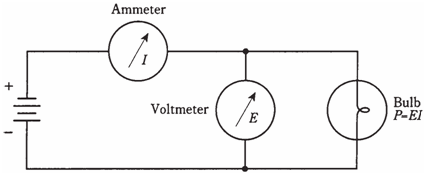Wattmeters
The measurement of electrical power requires that voltage and current both be measured simultaneously. Remember that power is the product of the voltage and current. That is, watts (P) equals volts (E) times amperes (I), given as P=EI. Actually watts are at times called volt-amperes in a direct current circuit.
You might think that you can connect a voltmeter in the parallel with a circuit, getting a reading of voltage across it, and hook up an ammeter in series to get the reading of the current through the circuit, and then multiply volts times amperes to get watts used by the circuit. And in fact, for practically all direct current circuits, this is an excellent method to measure power.
In a number of cases, the voltage from power supply is constant and and can be predicted. Utility power is a good example of it. The effective voltage is always close to 117 V. Although it is alternating current, and not direct current, power can be measured in the same manner as with direct current: by means of an ammeter connected in series with circuit, and calibrated so that multiplication has been done already.
An electric may might consume 1000 W, or the current of around 1000/117= 8.55 A. And a large heating unit may bolt up 2000 W, needing a current of 2000/117 =17. 1 A. This may blow the fuse or the breaker, as these devices are rated for only 15 A. You have probably had an experience where you hooked up too several appliances to a single circuit, blowing fuse or the breaker. The reason was that the appliances, combined, and drew

Figure-- Power can be measured with a voltmeter and an ammeter.
large current for the house wiring to safely handle, and fuse or breaker, detecting excess current, opened the circuit. Specialized wattmeters are required for the measurement of radio-frequency power (RF), or for peak audio power in the high fidelity amplifier, or for someother applications which are specialized. But almost all of these meters, use simple ammeters as their indicating devices.